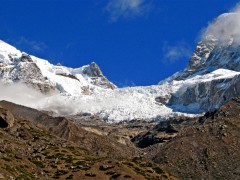India – A Future Without Fresh Water

Parthajit highlights the dire situation of an India without water in this photo journey
The one nightmare that is staring us right in the face today is the scarcity of fresh water. In India the situation is far worse because of a lack of proper policies to stop water pollution. It seems like policymakers have also turned a deaf ear to the need for adopting alternate sources of power and energy like wind power or solar energy. There are several hydropower projects in the pipeline and a few more are almost functional. According to a CAG report, 53 power projects are in the pipeline on just the Alaknanda and Bhagirathi rivers alone that form the River Ganges.

Receding glaciers due to global warming are a cause for worry! Mt Kanchenjau (6919m) and its glacier. Photo taken by the author (CC BY-NC-SA 3.0).
As a research study conducted by NASA in December 2009 shows, there has been a steady increase in black carbon particles and other pollutants settling on the Himalayan glaciers and which are responsible for accelerating the melting process. Glaciers are melting and receding including the Gaumukh glacier, the source of River Bhagirathi. The 2007 Working Group II report (WGII) projected that most Himalayan glaciers including the Gaumukh glacier will disappear by 2035.

Receding Glaciers = Dry Rivers = Less Fresh Water. The river Ravi in Himachal Pradhesh running dry in the monsoon. Photo taken by the author (CC BY-NC-SA 3.0).

Dams for hydroelectric power are making the fresh water situation worse. A hydroelectric dam on the river Teesta. Photo taken by the author (CC BY-NC-SA 3.0).
Apart from receding glaciers, fresh water pollution is another major concern. The irony of India is that we pollute the same rivers we revere like the Holy Ganges. On one hand, we worship the river at Haridwar or Benares, while on the other we carelessly dump waste including plastic and human waste into the selfsame river.

Increasing fresh water pollution leads to the death of fishes and other aquatic animals. Mahanadi, Orissa. Photo taken by the author (CC BY-NC-SA 3.0).
The nail in the coffin is the erratic nature of the monsoon coupled with the fact that we still do not have a strong water conservation plan in place to supply the future needs of an ever growing population and economy. What kind of future are we gifting to the next generation? A future riddled with ignorance, inaction, and apathy? A future without fresh water?

Ignorance about rain water harvesting = wastage of the precious supply of fresh water. Photo taken by the author (CC BY-NC-SA 3.0).
The economies of nations like India cannot grow without the people but with the depletion of natural resources like water, there will not be any future – neither for the people, the economy, nor the country!
(All photos by the author under Creative Commons)
Tags: drinking water, glacier, Global Warming, hydroelectric plants, hydropower plant, Natural Resources, natural resources and biodivesity, rainwater harvesting, water management, water scarcity

